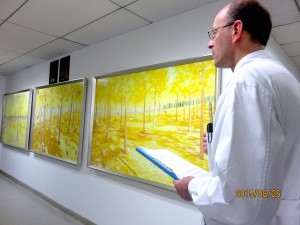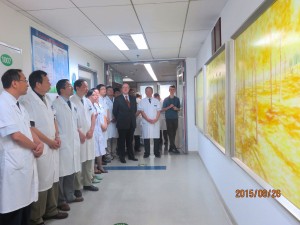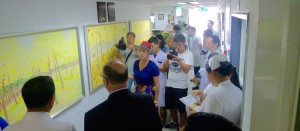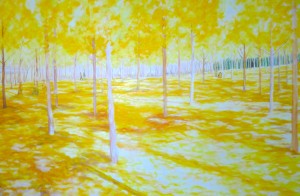Wednesday morning (Aug 26th 2015) was a special marker of my five years here in Beijing. Three large Ginkgo works were installed in the entrance that welcomes and directs visitors to the Orthopaedic Nurses station. The three paintings were unveiled by the Ambassador of Ireland to China Paul Kavanagh, Professor Wu Yu-qing President of Huaxin First Affiliated Hospital to Tsinghua University and Professor Daniel Porter head of the Orthopaedic centre.
Click here for the link to the hospital We chat post in Chinese
Why the Ginkgo tree?
Earlier this year Prof Porter spoke with me about what might be useful for the centre. He talked about the international symbol of the Orthopedic profession The Tree of Andry (named after the French Physician Nicolas Andry de Bois-Regard 1658-1742) where one straight tree splints a tree that is curved or twisted, once bound to the straight wood guiding it to grow straight again. The Ginkgo too would make a good splint as its trunks are very straight in form.
The ginkgo ( both leaf extract and seed) has been used in alternative medicine to treat conditions such as memory loss, anxiety and circulation and is often found in health stores. Ginkgo Biloba is the only surviving species of the Ginkgo family, it thrives as a city street tree as it is air-pollution tolerant. These primitive plants from as early as 280 million years ago may have evolved when the atmosphere was more grimy and sulphurous (due to volcanoes) than today.
When you look close at the flat leaf blade it is neither net veined nor parallel veined , the veins come from the base of the leaf and fan out towards the rim dividing as the extend to the edge. The veins continuously divide into two, this dichotomous venation is distinct and unique to the Ginkgo.
The Shape of the Ginkgo leaf where some leaves split into two parts was used by JW von Goethe in the poem Gingo Biloba to symbolize his philosophy of the one and the double coexisiting together.
Does it represent One living creature
Which has divided itself?
Or are these two, which have decided
That they should be as One.
Although it is the fan shape of the Ginkgo leaf that makes it so easily recognisable, I have denied illustrating the leaf definition in the paintings and instead focussed on the reflective light and occasionally used prepared treated leaves superimposed on the surface of the painting as you can see in the painting “They will not hush these leaves” which was first exhibited in ” Golden Fleece” at InterArt Gallery , 798 in March as part of the IRISH WAVE 2015.
Prof Porter wrote in the plaque above the paintings.
To us, the glade represents the world of the patient at Huaxin Hospital. Illness is personal and no-one else can share it, thus two works show no human activity. Even so there are paths to take which lead away from the patient existence. Moreover the patient is not left alone in a desert of suffering, but is surrounded by the protective totems of modern medicine. Here drugs, surgery and compassionate care combine to give the patient a space in which to heal. The gingko is a medicinal tree and here the falling leaves in the middle canvas offer healing.
“They will not hush these leaves”
A further canvas reveal the life of health – somewhat ephemeral – in the near distance; the life of children calling and playing, of adults striding to their daily duties on paths which take them away to the real and unitary life of the whole and healthy person. Though the road may sometimes be sinuous and difficult, our doctors and nurses strive to lead our patients onto those paths to health, which are our ambition and delight.
What can visual art offer centres of health and hospitals?
Health centres are becoming more interested in providing healing and aesthetically pleasing environments. A harmonious and uplifting environment helps soothe and welcome patients and visitors. It can assist with guiding a person to a central reception desk. Artwork can also help define the boundaries of public areas such as entrances, corridors and waiting rooms.
If you are interested in commissioning art works for your work place whether corporate or public please contact me on the website enquire page. I would be delighted to consult on possible options.








